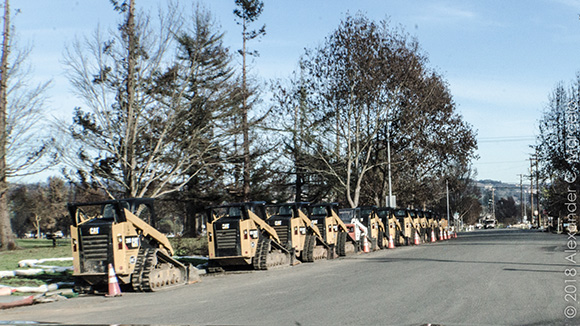
Coffey Park neighborhood in Santa Rosa, California (Photo Credit: R. Lex-M/Flickr)
Sonoma County is like California in a bottle. Many of the issues that are confronting other regions and the state overall are fermenting in conversations like the one this week at the North Bay Builders Exchange.
The organization of construction contractors – now preoccupied with rebuilding neighborhoods destroyed and damaged in the October firestorm – hosted the latest Future of Work MeetUps for the CA Community College Chancellor’s Office.
Keith Woods, the CEO of the exchange, said the shortage of qualified construction workers was slowing the recovery. But he also recognized the challenge was even bigger than replacing the homes and businesses that were lost in a few catastrophic hours.
“One of my heroes, Stephen Covey, may he rest in peace, said ‘You can’t talk your way out of a problem you behaved your way into.’”
The participants shared an ironic laugh. The rest of the morning was invested in finding a way for Sonoma County to behave its way out of situation where not every child acquires the skills for a first career, and then a second and third career.
The Future of Work MeetUps are designed for just this kind of engagement. The big picture: Technology and market forces are changing the nature of businesses, the talent they need to be successful, and the skills that Californians need to prosper. Some workers are likely to be “stranded” as the market for their skills disappear.
Working with the California Economic Summit and other partners, the Chancellor’s Office in recent years developed and is implementing the Strong Workforce Program – a strategic investment to align college programs with the skills needed to prepare Californians for jobs that pay better than minimum wage.
The Chancellor, at the direction of Governor Brown, is now developing a plan for a statewide online college designed to serve the two and a half million Californians who need additional skills but are not getting them from campus-based classes.
The group of 80 business, community, government and educational leaders in Sonoma saw potential in the platform, and focused their questions and comments on what it would take for the new pathway to successfully serve the hard to serve: young mothers who can’t afford day care, Spanish speakers who also may not be digitally fluent, and young adults who didn’t fare well in traditional school settings.
Executive Vice Chancellor Van Ton-Quinlivan said the new model would include individualized support, as well as a research component to identify and solve for issues slowing progress – attributes of other highly successful nonprofit or governmental online universities.
The platform also will be competency-based so students can learn and progress quickly. Classes will be offered with multiple start times to increase access to classes when students need and can take them.
The program will likely begin with a few focused pathways to refine the learning system and demonstrate the value to students seeking skills for a better paying job. For instance, Ton-Quinlivan said, some 93,000 openings exist for “first line supervisors” in 17 different industry sectors in California, from food service to retail.
The Chancellor’s Office is looking for employers willing to partner with the online college to develop these priority pathways.
The majority of the leaders surveyed at the Sonoma MeetUp anticipated that automation will have a meaningful impact on employers in the region – from the high vineyard and winery operations to office work – with 39 percent choosing “noticeable disruption” and 35 percent choosing “some disruption.”
Danielle Cagan, vice president of external affairs for CSAA Insurance Group, said her company was investing in data analytic platforms so workers need to learn to interpret the reports instead of creating them.
Cynthia Murray with the North Bay Leadership Council said: “The question is how do we prepare people to partner with robots — more creative thinking, more problem solving, all the things people can do and machines can’t. Every one of us is likely to be stranded if we don’t continue to add new skills. Each of us is going to have to keep up.”
Within minutes, the Sonoma leaders also realized the statewide learning platform would be most successful if the community was engaged to improve early learning programs, as well as K-12 education.
All students need to understand their choices and be prepared to pursue their dreams – whether that is a technical field like construction or a professional path through a university.
“The discussion on choices is really important,” said Santa Rosa City Schools Board President Jenni Klose. “Students are going to make choices at 17 or 18 when they graduate, and then they are going to be making choices every few years for the rest of their lives. I don’t know about you, but I don’t want to be stuck with my 16-year-old choices.”
The leaders agreed to start a task force to assess what they could do better as a community to prepare students for college and careers, avoiding the historic trap of tracking students into technical fields or professional ones.
Lisa Carreno, Sonoma County regional director for 10,000 Degrees, a project supporting low-income college students, called out the obvious in a community still very much recovering from disaster: “A broader community discussion about resilience needs to be elevated – throughout our education system and in our health care systems. It is one of those invisible things that we need to start talking about.”
The event was sponsored by the CTE Foundation of Sonoma County, Sonoma County Office of Education, the North Bay Leadership Council, Santa Rosa Junior College. For information on future MeetUps, please visit the event page.

